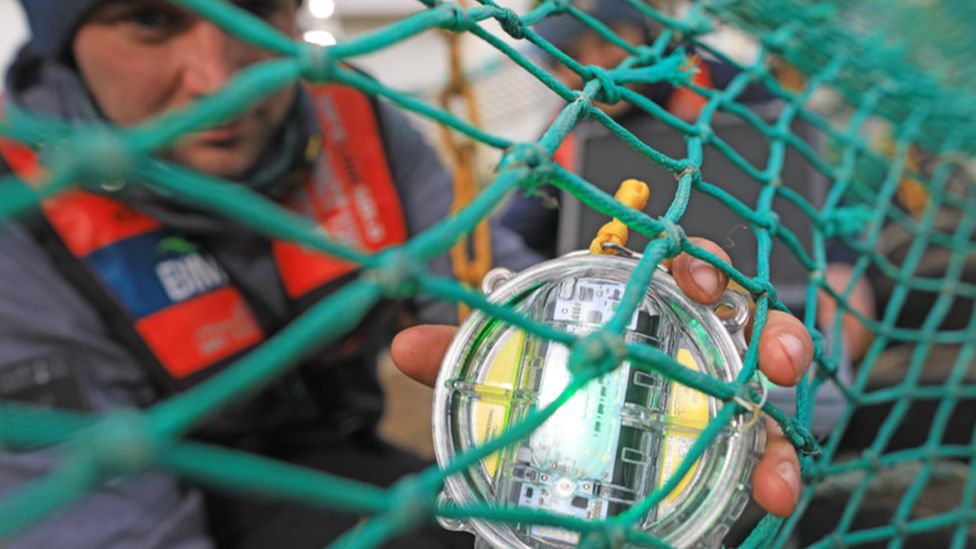ARTICLE AD BOX
 Image source, SafetyNet Technologies
Image source, SafetyNet Technologies
The LED light technology is being trialled by fisherman all around the world.
By Ashleigh Swan
Technology reporter, BBC News
It's 05:00 on a Monday morning in Largs Boat Harbour on the west coast of Scotland. The sun is yet to rise and the rain is getting heavier.
But Ian Whiteman is already out on the water, because over the next 12 hours, every minute counts.
He is going out for his daily catch of langoustines - something he has been doing for almost 40 years.
A faulty net, unwanted sea life in the catch, or a change in water conditions could delay deliveries to customers, and that could mean lost income for Mr Whiteman.
As the sun rises, he steers his boat through the waters of the River Clyde.
The next step for him is to position his boat and prepare the net. But before the net goes overboard, Ian attaches lights, cameras and sensors to it.
He is trialling devices from SafetyNet Technologies, designed to help fishermen understand what's happening underwater and reduce what's known as bycatch.
According to the World Wide Fund for Nature (WWF), bycatch is when fish and other animals such as dolphins and sea turtles become entangled in fishing gear.
Often bycatch is thrown back into the sea, but the creatures are usually dead or dying.
"It can significantly reduce ocean health and resilience, and this reduces the ability of ecosystems to respond to adverse conditions," says Alison Cross, director of fishery sustainability at the WWF.
Image source, SafetyNet Technologies
Image caption,The LED lights can attract or repel fishing depending on their colour
One of the devices Mr Whiteman is using has LED lights which can attract certain species of fish, while repelling unwanted mammals like dolphins.
Mr Whiteman also catches squid, and the lights help lure them towards the net. "It helps improves the catches and efficiency," he says.
Others have also been experimenting with different lighting kit.
A research team from Arizona State University conducted a study with Mexican fisherman in the Sea of Cortez. It found that illuminated lights reduced the average bycatch by 63%. It also found that the lights helped to cut down the time it took fisherman to retrieve and untangle nets by roughly an hour.
Ms Cross and the WWF have been working with fishermen around the world to trial the use of coloured LEDs lights as a way to minimise the chance of sea life getting caught up in catches.
The LED's the WWF are using are from San Francisco-based company Good Machine. Their studies found that using green lights have shown to be most effective at preventing turtles from being entangled.
The next step for the WWF is to test ideal light spacing, meaning they want to find a balance between eliminating turtle entanglement and making the lights as cost-effective as possible.
Ms Cross believes the use of the lights are a "win-win" solution for the ocean eco-system, as well as for the fishing industry.
"The lights have reduced bycatch overall, which has made it easier to spend less time out in the water [and] less fuel, so implementing this technology has actually increased the amount of money fishers are earning," she says.
Despite this success, some question whether the fishing industry will embrace the technology.
"I think the device is really good, but the price itself is not really competitive and accessible by locals," says Akbar Digdo, the chief executive of a non-profit organisation that encourages the use of technology to promote greener practices among Indonesian communities.
Mr Digdo has been trialling the SafetyNet lights with fishermen in West Java.
"We have to somehow couple this technology with a financing mechanism, so they can access it more easily," he says.
Image source, SafetyNet Technologies
Image caption,The camera attaches to the fishing net and allows fishermen to see footage underwater.
Another piece of technology used by Mr Whiteman is the Catch-Cam, a camera that attaches to the fishing net and allows him to see what is happening underwater via an app.
Before Mr Whiteman had the camera, he said it could take three to four days to find out if the net was working as efficiently as possible. But now, it only takes a day.
"It takes the guesswork out of it for us," he says. "It's opened a lot of information we didn't know that was actually happening in the net."
Enki is the third piece of technology used by Mr Whiteman. It is a data collection system that, once underwater, starts measuring data such as pressure, depth and temperature of the surrounding waters.
The unit automatically switches off when it leaves the water and sends the data to the cloud - remote computer servers which process and store information in data centres - which fishermen can then view.
"This is an extremely cheap way to put data collection on boats," says Mr Whiteman.
By mid-morning, Ian is sorting through his catch.
Later, sorting through his catch, Mr Whiteman is pleased the morning's work.
"You can see how little bycatch there is," says the fisherman, as he clears away only three unwanted fish from among the langoustine.
"We are not wasting fuel, time, effort - everything is being done as efficiently as possible," he says.
You can watch more on this story on BBC Click.

 1 year ago
38
1 year ago
38








 English (US) ·
English (US) ·